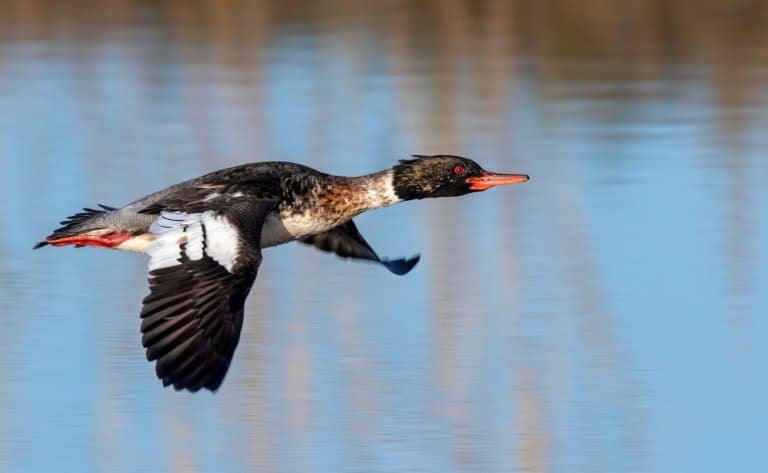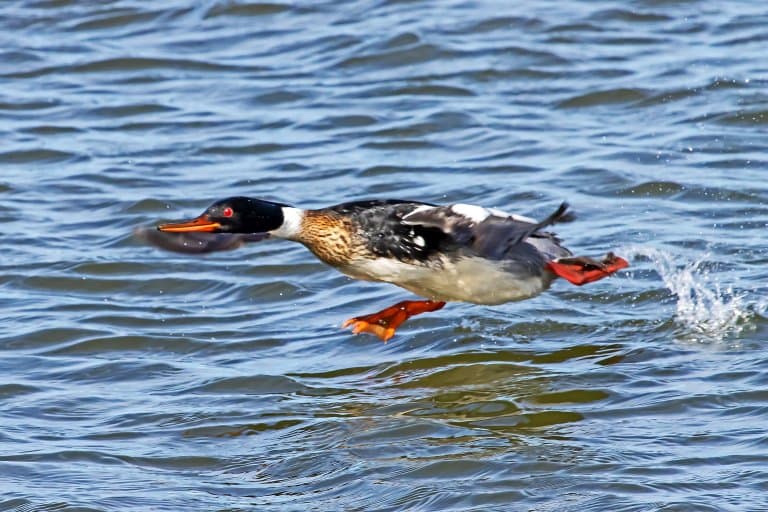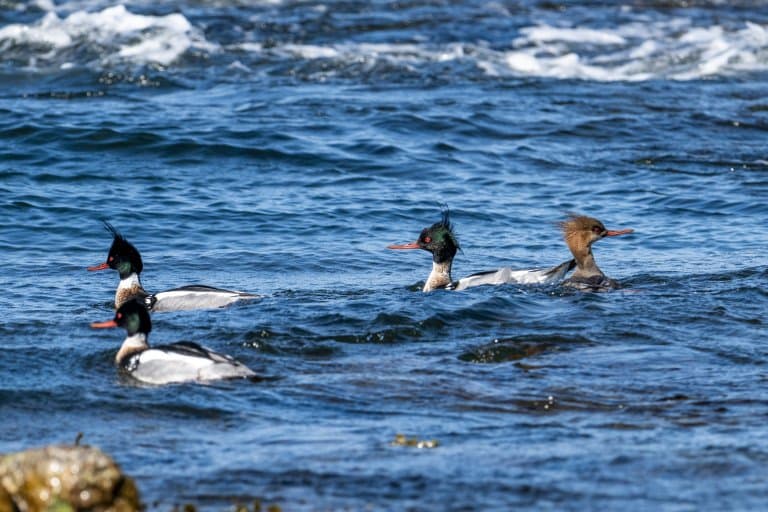Red-Breasted Merganser Profile
We mostly know ducks for being gobblers of pond weed and other green things. They’re rotund, exceptionally buoyant, and bob around on the surface like bath toys.
But there’s at least one genus that puts all these prejudices to the test.
The mergansers maintain the raptor-like quality of their ancestors, and the red-breasted merganser species is an exceptional example.
The red-breast that gives their common name is displayed by males in breeding plumage.

Red-breasted Merganser Facts Overview
| Habitat: | Boreal forest wetlands, often saltwater |
| Location: | Mainly Northern Europe, Russia, and N America |
| Lifespan: | Up to 9 years |
| Size: | 64cm (25 inches) long |
| Weight: | Up to 1.4kg (48oz) |
| Colour: | Black and white with a red eye and a rusty breast |
| Diet: | Fish |
| Predators: | Ravens, gulls, mink, foxes, humans, cats |
| Top Speed: | 161 km/h (100 mph) |
| No. of Species: | 1 |
| Conservation Status: | Least Concern (ICUN) |
The red-breasted merganser is possibly the fastest duck there is. It’s a streamlined, weirdly-proportioned bird, with a long neck and powerful propelling feet for diving to catch its food: fish.
It has a specialised beak and a unique mating display, and these seem to have worked well for the species, as they’re common in most of the Northern Hemisphere and in huge numbers.
They migrate each year from lakes and rivers where they breed, to warmer coastal wintering areas.
These social ducks defy convention in more ways than one and break records while they’re doing it.
Interesting Red-Breasted Merganser Facts
1. This is no ordinary duck
Mergus serrator looks like a duck and swims like a duck, but on closer inspection, there’s something unusual about it.
This is what’s known as a sawbill, and its beak looks very different than the common mallards, pochards or shovelers, all of whom have much wider, flatter beaks.
You can tell a lot about a bird by the shape of its beak, and the sawbills have a sharp, narrow dart-like facial appendage, covered in serrations. These serrations are present to some degree in all duck species, and often present as tiny lamellae that are used to trap algae and plant matter from the sludge they feed on.
In the Mergansers, they’re larger and sharper and form tooth-like protrusions. A beak like this is great for catching fish, so while the flatter beaked birds are snipping grasses and swilling plant matter, the merganser is actively hunting.
These ‘teeth’ give the duck its Latin name serrator, and help it grip its prey. While many duck species will eat a fish or two if they can catch them, they’re mostly vegetarian. Mergansers are unusual in that they feed primarily on fish.

2. They have a hankering for salmon
When duck hunting season comes along in North-East Scotland, researchers get a gruesome opportunity to learn about the insides of these birds.
Interestingly, they’re so effective at hunting fish they can even catch and eat one of the strongest freshwater swimmers: the salmon.
Juvenile salmon comprised up to 91% of the merganser diet, showing a huge preference for this particular fish, and making these ducks a significant predator and therefore selective pressure on salmon populations in the area.
Salmon lunches included catches of up to 115mm long or roughly a fifth of the length of the bird. 1
3. So fishermen don’t like them
These ducks are hunted for food by humans across their range, but in some cases, they’re specifically targeted as pests – animals in competition with anglers for their catch.
Fish farmers also accuse the birds of diminishing their stocks, and the combined persecution from these aggressors must have some impact on the species’ abundance, though quite how significant this is has yet to be established. 2
4. Still, they’re doing ok
There are some areas in which Merganser populations are threatened, not only by fish folk but also by pesticide poisonings and habitat destruction.
However, globally, these ducks are so widespread and abundant that their species security is of the least concern to conservationists, and global populations are thought to be stable.

5. They don’t quack like a duck
One of the other giveaways that this is a special kind of duck comes from the sound it makes. Or rather, the sounds it doesn’t make.
This is a very quiet duck, unlike its quacky brethren, and chooses to keep its opinions to itself. That is, outside of breeding season.
Once the hormones start flowing, these birds are capable of a peculiar repertoire of noises.
The male mating calls are said to have a cat-like quality, either in the loud “yeow” sounds or as a quieter purring. Females respond with a low bark, which further confuses things.
Males have a cute set of mating displays, one of which is referred to as a salute-courtesy, in which it will extend its long neck in salute, and follow up with a bow that takes it partially under the surface of the water.
After this, it’ll scoot off in front of the admiring females, do a couple of head bobs and then repeat the process. 3
6. They like to spend Winter on the coast
While these ducks breed on freshwater, they’re migratory, and when Winter comes along, they choose to move to somewhere with a nice warm coastal vibe.
These birds have been found over-wintering in the West Indies, choosing a far more tropical maritime climate than many freshwater species would enjoy. 4
7. They’re quite social
While they’re travelling, they like to keep good company. A flock of migrating mergansers may commonly reach up to 100 members, and while hanging out in the water, they’ve been known to gather in immense groups of up to 15,000.
They’re not fussy about whom they hang out with, either. They’ll tolerate members of other species as their own, and they’re not particularly territorial or defensive about where they sit or what they eat.
Only during the mating season will individuals break off from the group and go it alone to find a mate. 5

8. And they can really move
Ducks are notoriously fast animals and this particular species holds the highest ground speed legitimately recorded for any bird.
When chased by a plane, they maintained a speed of 129km/h (80mph), and with the tailwind of 32km/h (20mph), it’s said that this would have translated to a groundspeed of up to 161km/h (100mph), faster than any other duck known!
They came in at second on our fastest flying birds and animals in the world research.
9. They can dive, too
But one of the things that this predatory duck is best known for is its diving capabilities.
Its sleek head, agile frame and pointed beak allow it to dive for its food, sometimes further than nine meters down!
These dives can last almost a minute and are aided by the special position of their feet, right at the back of the bird, giving great power underwater, but making them walk kind of funny on land. 6
Red-Breasted Merganser Fact-File Summary
Scientific Classification
| Kingdom: | Animalia |
| Phylum: | Chordata |
| Class: | Aves |
| Order: | Anseriformes |
| Family: | Anatidae |
| Genus: | Mergus |
| Species: | Mergus Serrator |
Fact Sources & References
- M.J. FELTHAM (1995), “Predation of Atlantic salmon, Salmo salar L., smolts and parr by red-breasted mergansers, Mergus serrator L., on two Scottish rivers”, Wiley Online Library.
- “Red-breasted Merganser”, IUCN Red List.
- Peter Chen (2016), “Help! I’m a duck and I can’t swim!”, Youtube.
- “Red-breasted Merganser”, xeno canto.
- (1961), “The Flight Speed of a Red-breasted Merganser”.
- “Mergus serrator red-breasted merganser”, Animal Diversity Web.
